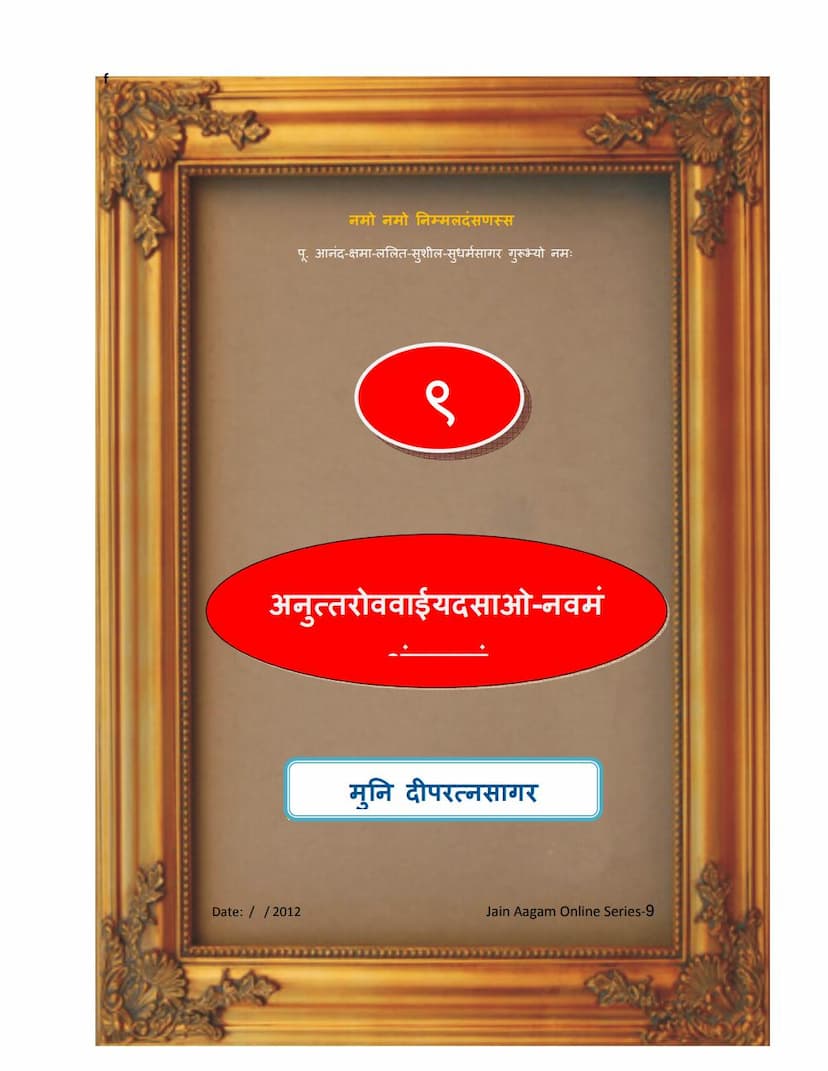Agam 09 Anuttarowaaiadasao Navam Angsuttam Mulam PDF File
Added to library: September 1, 2025

Summary
Here's a comprehensive summary of the provided Jain text, Agam 09 Anuttarowaaiadasao Navam Angsuttam Mulam PDF File, focusing on its content and structure:
Book Title: Agam 09 Anuttarowaaiadasao Navam Angsuttam Mulam (Anuttaraupapātikadaśāḥ) Author(s)/Editor(s): Dipratnasagar, Deepratnasagar Publisher: Deepratnasagar Jain Aagam Online Series: 9
Overall Purpose: This text, Anuttaraupapātikadaśāḥ (The chapter detailing exceptional ascensions/incarnations), is the ninth Anga (limb) of the Jain Agamas. It primarily focuses on the lives and ascensions of individuals who attained a state of unsurpassed enlightenment or celestial existence after their lives as ascetics under Lord Mahavira. The text outlines the structure of the Anga and then provides detailed accounts of specific individuals.
Structure: The Anuttaraupapātikadaśāḥ is divided into three Vaggas (sections), and each Vagga contains a certain number of Adhyayanas (chapters). The provided text details this structure:
- First Vagga (वग्गो पढमो): Contains 10 Adhyayanas.
- Second Vagga (बीओ वग्गो): Contains 13 Adhyayanas.
- Third Vagga (तच्चो-वग्गो): Contains 10 Adhyayanas.
Content Summary by Vagga:
First Vagga (10 Adhyayanas):
- The first Adhyayana details the life of Jāli Kumāra. It describes his renunciation under Lord Mahavira, his ascetic practices (including an eleven-month period of mendicancy), his death, and his rebirth as a celestial being in the Vijay dimension. The text mentions his lifespan and eventual liberation in Mahavideha Kshetra.
- The text indicates that the remaining nine Adhyayanas in this Vagga follow a similar pattern, focusing on other individuals. It lists some of these individuals: Matali, Upajali, Purushasena, Varishisena, Dirghadanta, Latthadanta, Vehalla, Vihayasa, and Abhaya Kumara.
- It also provides details about their parents and the duration of their ascetic practice (e.g., sixteen years for some, twelve years for others).
- The ultimate destiny of these individuals is described as rebirth in celestial realms like Vijaya, Vaijayanta, Jayanta, Aparajita, and Sarvasiddha, with the majority eventually attaining liberation in Mahavideha.
Second Vagga (13 Adhyayanas):
- This Vagga features thirteen Adhyayanas, detailing the lives of thirteen individuals.
- The first Adhyayana of this Vagga focuses on Dirghasena. Similar to the accounts in the first Vagga, it describes his renunciation, asceticism, death, and subsequent celestial birth.
- The text lists the names of the individuals covered in this section: Dirghasena, Mahasena, Latthadanta, Gudhadanta, Suddhadanta, Halla, D humasena, Mahadhumasena, Simha, Simhasena, Mahasimhasena, and Punyasena.
- The information about their ascensions, lifespans, and eventual liberation in Mahavideha is reiterated.
- The ascetics in this section also practiced intense austerities, including month-long fasts (Masika Sanlekhana).
Third Vagga (10 Adhyayanas):
- This Vagga contains ten Adhyayanas.
- The first Adhyayana focuses on Dhanna. The narrative describes Dhanna as the son of a wealthy merchant named Bhadra in the city of Kakandi. Upon reaching adulthood, he renounced worldly life and became an ascetic under Lord Mahavira. The text vividly describes the emaciated state of his body due to severe austerities, comparing it to dried bark or old footwear. It emphasizes his rigorous fasting, including alternating fasts of six days (Shashthashthama) and solitary meals.
- The text recounts Dhanna's unwavering determination in his asceticism and his acceptance of alms, even when they were mixed or difficult to obtain.
- It details his deep spiritual practice and eventual death and rebirth in the Sarvasiddha Vimana (celestial abode). His lifespan as a celestial being is stated to be thirty-three sagaropama (a unit of celestial time), and he is destined to attain liberation in Mahavideha.
- The text also highlights King Shrenika's admiration for Dhanna's exceptional asceticism and penance, calling him a great achiever of difficult tasks and one who accrues significant merit.
- The second Adhyayana of this Vagga focuses on Sunakkhatra, another son of the merchant Bhadra. His life story, renunciation, and ascetic practices are presented in a similar fashion to Dhanna's, with the same ultimate destiny of rebirth in Sarvasiddha Vimana and eventual liberation.
- The text mentions that the remaining eight Adhyayanas in this Vagga cover other individuals whose lives and ascensions are described similarly, with many achieving liberation in Mahavideha. The text lists the places where some of these individuals resided (Rajagriha, Saketa, Vaniggrama, Hastinapura) and mentions the specific ascetic practices they undertook.
Key Themes and Concepts:
- Asceticism and Penance (Tapa): The text emphasizes the rigorous ascetic practices undertaken by the individuals, including fasting, self-discipline, and renunciation.
- Celestial Rebirth (Devatva): Many of the individuals described attain rebirth in higher celestial realms due to their virtuous actions and spiritual accomplishments.
- Liberation (Moksha/Siddhi): The ultimate goal for all these beings is liberation from the cycle of birth and death, which is described as occurring in Mahavideha Kshetra.
- Guru-disciple Relationship: The dialogues between Lord Mahavira and his disciples (like Jambu and Gautama) highlight the transmission of knowledge and the understanding of spiritual principles.
- Emphasis on Exemplary Lives: The Anuttaraupapātikadaśāḥ serves as an account of exemplary lives that provide guidance and inspiration for spiritual seekers.
- Detailed Descriptions: The text offers detailed descriptions of the physical condition of ascetics due to their austerities, using vivid similes and metaphors to illustrate their emaciated and detached state.
Editorial Note: The text is presented as a revised and edited version by Muni Dipparatnasagar, indicating that it is a scholarly edition preserving the original teachings.
In essence, the Anuttaraupapātikadaśāḥ (Agam 09) is a pivotal Jain scripture that elaborates on the lives of individuals who achieved extraordinary spiritual heights, leading to rebirths in elevated celestial realms and ultimately to the final liberation, demonstrating the path of rigorous asceticism and unwavering devotion to Jain principles.